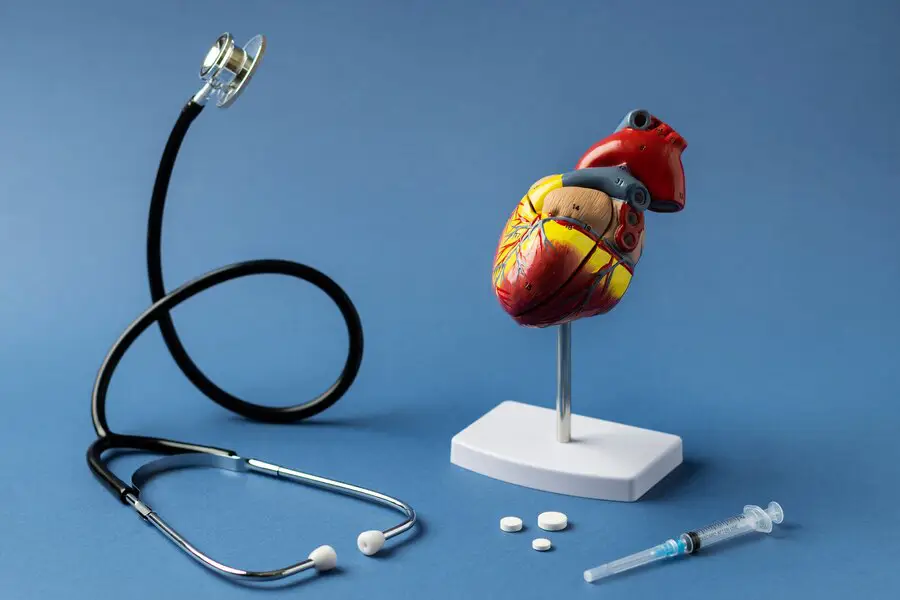The Top Risk Factors for Developing Heart Disease and How to Reduce Your Risk
Every year, a staggering number of people fall prey to heart disease, which is the most common
international killer. However, many risk factors are within our control. This blog post will cover the main risk factors for heart disease and how to minimize their impact on your heart health. Let’s hit it and improve our lives without further ado!”

Introduction to Heart Disease
Cardiovascular diseases encompass several conditions, including but not limited to Artery blockages, hypertension, heart defects, high blood pressure, and heart failure. As reported, there are 17 million deaths across the globe every year from heart disease, which makes it one of the biggest killers.
It is the primary reason people should understand any conditions affecting the heart. The heart is a powerful organ whose sole purpose is to pump blood, oxygen, and necessary nutrients to other body parts. If any diseases evolve, they can cause severe health issues.
Coronary artery disease is the most widespread form of heart disease. It develops when plaque accumulates in the arteries surrounding the heart. If that plaque builds up further, blood flow to the muscle will be obstructed. Left untreated, this issue can lead to chest pain, also known as angina, and even a heart attack.
Other forms of cardiovascular disease include:
- Arrhythmia – a condition that describes an irregular heartbeat.
- The condition of cardiomyopathy describes the heart muscle disease or weakening of the heart muscle.
- Valvular heart disease – damage or defects in one or more heart valves.
- Congenital heart defects – structural problems of the heart and great vessels that a person is born with.
While some forms of heart disease can be familial or secondary to other diseases, many factors predispose a person to acquire this disease. Risk factors are modifiable or non-modifiable.
As stated by its name, non-modifiable risk factors cannot be modified; however, they assist in developing cardiovascular diseases in specific individuals. Turning points such as age, gender, family history, race (ethnicity), and a history of having a stroke or heart-related attack.
Lifestyle changes and or medical treatment efforts can help decrease the chances of occurrence of modifiable risk factors. Some of the modifiable ones include Controlling smoking/tobacco use, hypertension, hyperlipidemia, diabetes, overweight and obesity, calorie-rich diets devoid of fruits/products while still being inactive, and sharply drinking alcohol.
The effects of changing our current lifestyles positively and dealing with modifiable risk factors directly can lead to a discord considerably lower than or equal to a 100% risk factor for heart disease. This article will discuss ways to reduce heart disease risk factors.
Understanding the Risk Factors
Heart disease is one of the leading causes of death in the world and takes millions of lives every year. Some risk factors, such as age and family history, cannot be altered. Many risk factors can raise the risk of heart disease. In this article, we will explore some common causes that lead to heart disease and ways to mitigate your chances of developing it.
- High Blood Pressure: Along with strain, Hypertension forces your body to exert more effort than is deliberately required. This excess force could potentially harm the arterial walls, hence the increased risk of heart disease.
To minimize the chances of Hypertension, it is recommended to limit the intake of alcohol, salt, and stress while maintaining a balanced weight and exercising frequently. - High Cholesterol: Cholesterol is a substance that is soluble in blood and it is critical for the existence of a healthy cellular structure. However, Cholesterollesterol can contribute to the artery walls becoming thicker or clogged, leading to an increased risk of heart disease. Following a low saturated and trans fat intake diet can aid in controlling heart disease due to high cholesterol
- Smoking: The use of Tobacco products is the single most contributory factor towards heart disease, which is modifiable through prevention and cessation of Tobacco. Cigarette smoke is made up of more than seven thousand chemicals that puncture the arterial walls and raise the heart’s heart rate and blood pressure, all factors facilitating heart disease. Not only does one reduce their chance of obtaining heart disease, but their general health improves after cessation of smoking.
- Physical Inactivity: When a person lives a sedentary lifestyle, the likelihood of medical complications such as obesity, increased blood pressure, and diabetes forms, all of which can lead to heart disease. On the other hand, keeping oneself active can assist one in being in shape, reducing harmful cholesterol levels, and opting for better heart health. Work out 5 days weekly, exercising for half an hour daily to minimize the chances of getting heart disease.
- Bad Eating Habits: A high consumption of saturated fats, trans fats, salt, and added sugars results in heart disease. Such diets lead to obesity, high blood pressure, and increased cholesterol levels, which are the most significant risk factors for developing heart disease. To lower your risk, try a healthy diet, especially with enough fruits and vegetables, grains, low-fat proteins, and essential fats.
In light of these significant heart disease risk factors and how they can be changed through a healthy lifestyle, if one acts upon doing this, then the probability of suffering from this life-threatening disease is minimized a great deal. Please share this discussion with your doctor or other health professionals who may be able to address your concerns about managing such risk factors.
– Age and Gender
Two critical risk factors for heart disease include age and gender. Due to the changes that occur to our hearts and blood vessels as we grow older, so too does our likelihood of developing heart disease. The American Heart Association has noted a staggering 85% of individuals with coronary heart disease are aged above 65.
In consideration of women, men are at a higher likelihood of developing heart disease since they tend to produce it at younger ages and display certain risk factors, including smoking, high blood pressure, and high cholesterol. But with that said, as women grow older and go through menopause, their chances of developing heart disease grow exponentially, considering their estrogen levels drop.
Now, thinking about it, it makes sense why age and gender are risk factors, considering hormones impact plaque accumulation in arteries. For instance, estrogen helps to retain HDL (good) cholesterol levels while preventing more LDL (bad) levels from accumulating. Women with lower levels of estrogen are, therefore, more likely to build up plaque in their arteries, which increases their chances of developing heart disease.
Age is not the only item that increases the risk of heart disease; the kind of lifestyle you lead through these years adds to this risk as well. It must be known that as age increases, people tend to become increasingly sedentary, which results in obesity, high blood pressure, and diabetes. All of these factors heavily increase the risk of developing heart disease.
The good news is that you are not meant to develop heart disease due to age or gender bias; as such, heart disease can be prevented by living a healthy life. There are numerous ways through which the overall risk can be reduced, regardless of age and gender.
To begin with, it’s imperative for everyone—regardless of gender or age—to make regular appointments with their doctor for check-ups and screenings with a focus on the health of their cardiovascular system. This entails blood pressure, cholesterol, body fat, waist circumference, and family history of cardiovascular disease evaluation.
In addition, The following risk factors for heart diseases have been identified: poor dietary choices, lack of physical exercise engagement, excess saturated fat and processed foods consumption, smoking, high stress, depression, and so forth.
Indeed, age and gender influence the risk of developing heart disease. However, these are not the only risk factors. Adopting a healthy lifestyle and regularly visiting a doctor can significantly help reduce the chances of heart disease.
– Family History
The risk of contracting heart disease is greatly influenced by family history. According to the research, the chance of an individual getting heart disease increases by 50% if any family member has a heart disease history. Specific genes elevate the risk of high blood pressure, high cholesterol, and obesity, which are major contributors to heart disease.
Some people fear that due to having a family history of heart disease, they are bound to get the disease. This is not the case. While it is possible that you cannot get heart disease, you have to understand that your chances are increased, and you need to take precautions. One of the best forms of precaution is going for regular check-ups and screenings so that any issues can be dealt with in the first place.
Other factors present in the family, aside from DNA, can also put an individual at a greater risk of developing heart disease. Dietary habits, for example, are present every day in families. If a family has unhealthy eating patterns or leads a sedentary lifestyle, heart disease is more likely to develop. Alternatively, a healthy diet, walking numerous times a week, or exercising can help lower the risk.
Caution is required against practices such as smoking and heavy drinking, which are inherited within the family due to environmental reasons. These greatly enhance the possibility of a person suffering from secondhand smoke to develop heart disease.
It is also worth noticing that heart disease is more likely to occur in people of certain ethnicities because of genetic dissimilarities. For example, African Americans and South Asians have a high prevalence of diabetes and hypertension, which are significant causes of heart disease.
Regardless of a person’s family history regarding cardiovascular disease, there are still ways in which one can minimize the chances of heart disease, even if the family history of such ailments remains grim.
- 1) Consuming a balanced diet consisting of vegetables and fruits while fully exercising discipline in avoiding smoking and drinking regularly is recommended.
- 2) Monitor blood pressure, cholesterol, and blood sugar periodically so that abnormalities can be addressed in a timely manner.
- 3) Strategizing with a physician the course of action to take so that the risk factors for heart disease can be handled in a timely manner.
Although family history is critical in assessing one’s risk of heart disease, it should not prevent people from being encouraged to lead a healthy lifestyle. Diet, lifestyle, and health monitoring changes can significantly reduce heart disease risk.
– High Blood Pressure
Hypertension, which is more commonly referred to as high BP, is one condition that causes or even worsens heart disease. Hypertension is when blood pressure is consistently too high against artery walls. This may lead the heart and blood vessels into unwanted stresses, predisposing them to heart-related diseases, which might include stroke, heart attack, or heart failure.
In the USA, out of all adults, around 46% have been diagnosed with high blood pressure, as stated by the American Heart Association. Now, this statistic speaks volumes and gives hope to grasp preventative measures to seek or treat hypertension before it escalates to heart disease.
There are two major types of high blood pressure: primary (essential) hypertension and secondary high blood pressure. The primary type is enhanced over the years due to lifestyle, nutrition, and even stress factors, while the secondary type can be due to a medical condition or some medication.
The biggest issue I have with high blood pressure is the fact that there are almost no indications that one is developing this ailment and that it has a good chance of being diagnosed when it is in its dangerous stages, with some exceptions being my patients experiencing a headache or perhaps a bleeding nose. However, these are also not good diagnoses as those can be caused due to other reasons that are not related to blood pressure. Thus, the only way to determine whether or not one has high blood pressure is to take it regularly from a trained professional.
Regular exercise is essential to lowering the risk of being diagnosed with this ailment, but combining it with a healthy diet is even better. A proper diet consisting of fruits, lean meats, vegetables, dairy products, and unprocessed food items is an effective hypertension treatment. In addition, maintaining your salt intake under 2 grams per day does wonders as well.
Moreover, how many times a day you exercise also matters; for example, exercising for thirty minutes for a large part of the week is beneficial. Additionally, talking from regular exercise patterned out will improve cardiovascular by ensuring a stronger heart muscle and improved circulation.
Another important thing that can help control pressure is stress management through relaxation techniques, be it meditation or practicing yoga. In a nutshell, ceasing to smoke and minimizing the intake of alcohol becomes quite helpful in lowering hypertension and heart-related illnesses.
Sometimes, managing hypertension might require medication in addition to maintaining a healthy lifestyle. Always consult with your physician and check your blood pressure levels frequently.
Researchers have found that high blood pressure is the leading cause of heart-related illnesses. The good news is that it can be prevented or at least controlled by adopting healthy habits. A healthier lifestyle, which includes managing stress levels, regular exercise, smoking cessation, and moderating alcohol intake, will significantly improve our overall health and lower heart disease probabilities. Preventive care should not be overlooked, so routine visits to a healthcare professional are highly recommended to catch developing concerns as early as possible. Never forget that, regarding heart health, it is better to prevent an illness than to treat it.
– High Cholesterol
Cholesterol is essential to some degree within the body; however, it is a waxy substance. Too much of it can accumulate and result in dire health issues for organs. Constant elevation of cholesterol and extreme heart diseases is considered to be one of the Primary Risk Factors.
Cholesterol can be split into two damage levels: good and evil. “Low-density lipoprotein,” or LDL, is typically called lousy cholesterol as it promotes plaque build-up within arteries. In contrast, HDL’s function is entirely reversed as it absorbs excess cholesterol in the blood and is known as “high-density lipoprotein. “”
An overabundance of LDL cholesterol promotes other substances to mix and form a plaque that will block the interior walls of your arteries. Arteries begin to become narrow and less able to exercise flexibility, inhibiting blood flow. When a clot is formed within one of the narrower arteries, oxygenated blood will not reach your heart, forcing it to initiate a stroke or heart attack.
There are several reasons for elevated LDL cholesterol levels, such as a person’s genetic predisposition, daily meals, active or sedentary lifestyle, age, male or female, and diseases such as diabetes or hypothyroidism. Bad personal habits can also contribute to raised cholesterol levels, like a diet comprising of saturated and trans fatty acids present in processed foods and red meat or smoking.
Cholesterol is a condition that can be treated, and taking simple steps can go a long way toward managing its effects. The diagnosis might seem scary at first, but the prognosis and treatment are straightforward. The good news for most people is that. Engaging in dietary changes is one way of decreasing high levels of CAD LDL cholesterol. Soluble fiber from apples, berries, and other foods lowers LDL cholesterol levels because it combines with bile acids containing cholesterol to be removed from the body during digestion.
Increased physical activity is known to lower the bad cholesterol and elevate the good cholesterol. At least 30 minutes of moderate to vigorous exercise, 5 times a week, is recommended.
There are people whose lifestyle changes cannot lower their cholesterol levels, and in such circumstances, drugs can be prescribed. The most frequently recommended medicine for high cholesterol is statins. They inhibit a particular chemical in the liver from producing cholesterol.
Regulating cholesterol levels is key to heart disease risk management. Along with sensitive medical advice and care, a healthy nutrition plan and a consistent workout regimen can help improve cholesterol levels while promoting heart health. Pointer: Ask your doctor to recommend medications for cholesterol improvement.
– Obesity and Physical Inactivity
Poor lifestyle choices, such as being physically inactive and classified as obese, are two leading factors contributing to heart disease. They tend to correlate and complement each other very well. The rates of obesity have been on the rise due to us becoming more and more sedentary while consuming unhealthy meals. This will also further reduce any physical activities that you would engage in.
Obesity is a condition that indicates the presence of excessive accumulated body fat that adversely affects health. It is caused by borderline BMI, which is your weight and height ratio. A measure of 30 % or greater is tagged as Obese, and that between 18.5 and 24.9 is termed the Normal range.
Obesity tends to strain the heart and other working muscles. For example, they work roughly more than before in relevant blood pumping, which could increase blood pressure, high cholesterol, and heart disease.
Besides in-activity, regular exercise promotes better circulation, thus keeping your heart fit. When you as a person do not exercise often, it will stroke other risk modifiers that can include diabetes as well as obesity, cholesterol, and blood pressure.
Excessive weight gain can result from a lazy lifestyle, which is a critical risk factor for heart disease. When we fail to work out, it becomes easier to consume more calories than to burn extra calories through exercise. This in itself is a death blow. But heart disease is also a death blow.
Fortunately, obesity and physical inactivity are both preventable. This means there are things we can do to prevent them from developing. Altering our lifestyle to a healthy one by eating and doing at least 30 minutes of physical activity daily reduces the chances of heart disease.
The simplest ways to boost the chance include exercising after eating out or taking the stairs instead of elevators. Another way is taking bike rides or dancing, which makes blending fun into exercise easier.
Making big changes in your lifestyle can prove difficult, and sometimes, you may need to reach out to a doctor or even your family and friends for help. That said, if you manage to control your weight actively, you are doing great in decreasing the likelihood of developing heart disease. Any work towards improving your health is good, and it should be remembered that every little tweak matters.

Lifestyle Changes to Reduce Risk of Heart Disease
If paid attention to, the following two factors can significantly reduce the chances of cardiac illnesses. Making basic alterations to our everyday routines will bolster our chances of not having heart disease.
- Avoid being Overweight: People who are overweight have an increased risk of heart disease, but those who have come into the obesity bracket are in even dire circumstances. Overweight people have a high chance of getting hypertension, dyslipidemia, and diabetes. To lower these chances, one must consume ample fruits, vegetables, whole grains, skinless poultry, and low-fat dairy products, as Healthy People 2020 recommends.
- Cardiovascular Activities in Daily Routine: Making exercising a habit in the individual’s daily routine can help ease stress. It can also help bolster body weight and improve blood circulation. Ultimately, these changes would help lower blood pressure and cholesterol levels, which in return would have a positive impact on heart diseases. To be more productive, one must aim for at least moderate intensity levels for 30 minutes daily.
- Give Up Smoking: Smoking recklessly harms the arteries, increasing blood pressure, bad cholesterol (LDL), and blood clot risk, thus becoming one of the most significant risk factors for heart disease. In addition to heart disease, putting an end to smoking also raises lung performance and reduces the chances of getting cancer. On the other hand, being a smoker increases the chances of getting these aforementioned health complications.
- Manage Stress Levels: Chronic stress diminishes both mental and physical health by causing chronic inflammation, a factor contributing to heart disease, among other things. Many stress management techniques exist, including focused breathing, where you actively control the steady flow of air and focus on each breath, or something as simple as meditation.
- Limit Alcohol Intake: Even modest alcohol intake contributes to hypertension, which is a common cause of heart failure. Since women are at a greater risk than men of developing coronary heart disease, alcohol intake should be limited to a moderate level of one drink per girl per day and two for a boy.
Making these lifestyle changes lowers one’s chances of developing heart disease. These measures are simple to accomplish and can greatly help maintain good heart health in the long run.
– Healthy Diet Tips
In addition to engaging in physical activity, healthy eating habits are essential in preventing heart ailments. Nutrition has a significant influence on human health and can also impact the condition of the heart, including Diet. This section gives a few strategies to eat healthily to protect yourself from heart disease.
- Be Consistent In Eating More Fruits and Vegetables: Consuming fruits and vegetables enhances nutrition through their vitamins, minerals, and antioxidants. These have wide-ranging benefits for the human body, including the heart. You can include them in your Diet, in salads, soups, smoothies, and even as snacks throughout your day.
- Go For Whole Grains: Brown rice, quinoa, oats, whole wheat bread, and pasta are whole grains rich in nutrients and fiber. Whole grains do not have the additional sugars or unhealthy fats of processed grains. These nutrients assist in controlling high blood pressure and cholesterol levels, which puts someone at risk of heart disease.
- Limit the Consumption of Saturated and Trans Fats: Saturated fats are dangerous and shouldn’t exceed 10 percent of your daily caloric requirements. A prime source of these fats includes animal products like red meat, butter, and cheese. Trans fat is also found in a wide range of processed foods. It contributes significantly to elevating the quantity of bad Cholesterol (LDL), which evidently increases the chances of heart disease. Avoid trans fats altogether, as they are known to increase the level of lousy cholesterol while decreasing good Cholesterol (HDL).
- Healthy Fats are also Important: Fats are not entirely harmful; there are suitable types of fats, like monounsaturated and polyunsaturated, which, when taken in moderation, have been determined to be beneficial to the heart. These are also abundant in fatty foods such as avocados, nuts/seeds, fatty fish (salmon), and olive/avocado oil, among others.
- Reduce Sodium Intake: An increase in sodium consumption has been correlated with an increase in the risk of heart disease, which is especially troubling for people with high blood pressure. Instead, use herbs and spices, bake, or use lemon juice to flavor your food.
- Added Sugars Restraint: Heart-related diseases are frequently associated with overeating of sugar. Avoid added sugars from sweetened beverages, desserts, and snack foods.
So, when you make meals and snacks at home or order in, try to follow these healthy diet tips, and you can prevent” heart disease.” Keep in mind that these small adjustments in the way you eat can potentially keep your heart healthy.
– Regular Exercise Routine
Exercise is crucial to a healthy routine and is significant in preventing cardiac illnesses. Regularly engaging in physical activity has numerous constructive outcomes on the heart and blood system, such as enhancing blood circulation, decreasing high blood pressure and the risk of heart failure and stroke, and many more advantages.
For maximal advantages regarding heart health from exercises, one should do at least 30 minutes of moderate-intensity aerobic activity on five non -non-consecutive days or do vascular 20-minute aerobic activities 3 times a week. Moderate-intensity activities include brisk walking, cycling, swimming, and dancing, whereas vigorous-intensity activities include jogging, hiking, playing soccer or basketball, or short bouts of high-intensity interval training (HIIT).
In addition to aerobic exercises, engaging in a 30-60-minute session of strength training at least twice a week is also beneficial. For instance, using weights or resistance bands to increase muscle mass or performing daily tasks more effectively with more significant overall body strength and function.
Many people today consider including regular physical exercises in their schedules challenging. For instance, opting for the stairs instead of the lift or parking the vehicle a little farther from one’s spot helps someone become more active every day, which, interestingly, is relatively easy to do. One can also perform some mild exercises in between work breaks.
People should select the exercises that give them pleasure and that they would like to do for a long time. For instance, people could go to the gym or fitness classes or enjoy walking with friends or family. If someone wants to do this, they could look for an exercise buddy who would help them stay motivated in their exercise routine.
People do believe a misconception that to exercise for the heart; one needs to be a member of an expensive gym and spend money on good equipment. However, this is not true. There are a myriad of inexpensive alternatives, such as low-cost outdoor activities like hiking or cycling and exercises that do not require any equipment at all.
Focus on all heart-healthy activities cumulatively, as consistency is one of the most critical factors. Exercising every day, even if it is at moderate intensity, is always better than performing vigorous exercises but not regularly. Depending on your body and the condition of any heart issues, please consult a doctor prior to undertaking a new exercise program.
Its benefits extend beyond improving heart health to better mental health, stress management, and quality of life. Set your goals small and increase the frequency slowly; then, you should notice an improvement in your heart health from a steady exercise schedule in no time.
– Stress Management Techniques
Stress is a common factor many people encounter daily and adversely affects human health. One such risk factor for developing heart disease, which, according to most reports, is the leading cause of global death, is chronic stress. In order to decrease the chances of experiencing heart disease in the future, individuals must learn the proper methods for handling stress.
A strategy for stress management can ameliorate individuals’ health status and enable them to cope. It is equally important to identify the inducers of stress, such as work-related problems or problems related to finances or relationships.
People believe they can practice meditation, yoga, or deep breathing exercises while under stress. Such techniques have been shown to enhance health by increasing muscular relaxation, decreasing blood pressure, and improving mental well-being.
A healthy lifestyle is the preferred way of managing stress and is vital to ensuring one remains healthy. An example is Whole Foods cuisine, comprised of lean protein, whole grains, fruits, and vegetables. Cutting back the processed food intake rich in sugars and bad fats can benefit the body and mental welfare.
Depending on the condition, seeking support from those close to you, therapy, or counseling can help. Sharing your worries with someone experienced is rational as it expands thinking. In addition, certain daily boundaries and self-care are essential, such as sleeping adequately, taking breaks, and carrying out duties one enjoys.
Time management can disrupt long-term patterns of stress in one’s body. Reasonably mapping goals and deadlines will ease the burden and enhance time management for a healthier and more peaceful lifestyle.
Cardiac disorders never go easy, so stress avoidance is key to maintaining heart health for a longer duration. Stress management techniques, including self-care, assist with improving one’s health and overall well-being. Selwellbeingms is the basis for long-term heart health maintenance and includes relaxation techniques, exercise, lifestyle modifications, and support when needed.
– Quitting Smoking
Giving up smoking is one of the best things you can do to minimize your chances of getting heart disease. This is mainly because tobacco hurts one’s heart health. First, it causes damage to blood vessels. Second, high blood pressure and dangerous blood clots are another consequence. If you stop smoking, then you are likely to enhance your heart health and increase your chances of avoiding the disease in the long run.
To start, when you take a drag of a cigarette, the nicotine-infused paper you light on fire interjects into your bloodstream. Because of that, your arteries are bound to get damaged, and inflammation is one of the consequences. Arteries narrowing constantly leads to blood flow issues due to increased pressure. Your heart also has to work harder than it usually would, which can lead to future problems, including strokes and heart attacks.
To add on, high cholesterol levels are another side effect of smoking. “Bad” cholesterol, also known as LDL, is increased, whilst “good” cholesterol — HDL — is decreased, resulting in a disorder that leads to arteries forming plaque, which later results in heart disease, all due to smoking.
The good news that can be said with certainty is that there is a way to significantly lower these risks regardless of age, according to Frank v.
As early as 20 minutes after quitting, the rate is returned to a normal level, which means his heart beats slower. The blood level of carbon monoxide goes down to normal about twenty-four hours after the consumption of a cigarette is stopped. And with the additional never smoking over the years, lung power is restored, and blood flow commensurate with health.
But again cig, cigarette smoke is not the only one to be avoided, as even passive smoke is more detrimental to those who have never touched a cigarette.
So, suppose you are unable to reduce consumption with no support effectively; there are several options available even to those who have help, from taking replacement forms of nicotine to attending support groups for people who want to dump cigarettes for good.
Legal age smoking has been associated with cardiovascular diseases even in adolescents since recent studies have shown that the risk factor for developing ischemic heart disease increases tenfold with the use of tobacco. Interrupting the habit significantly cuts the risks of many forms of cancer that potentially exist, including lung cancer, severe coronary heart disease, and vascular pathologies (myocardial infarction, stroke, and aneurysms.) Stopping smoking will benefit your heart and can be done at any stage of your life with dull pain in the right arm.

Medical Interventions for High-Risk Individuals
Medical care must be everywhere, if not most especially, provided in primary care for individuals at higher risk for cardiovascular diseases. Such provisioning ensures that the development of cardiac risk factors is reduced or, at the very least, not progressed by much, and one’s health is kept intact to a greater extent than without such measures.
Mild heart attacks, for instance, can clip an Eglinton knife-earnout low to enlargement, transforming sound structures cavity. Anoog Thomas, a pharmacy assistant, suggests that it is best to treat women and men with irregular vascular coating or hai and provides them with a methodical clock and blood pumping methods to capture them.
When clients have warm and congenial experiences within the safe – ambivalent functional therapy sessions that transcend much anxiety and dread – they will open up. They will allow us to guide them in seeking objective lifestyle changes, including the anti-inflammatory processes of wearing everyday socks, neat foot forms, and reducing cervical forward posture, which are necessary changes.
Surgical procedures like CABG or angioplasty with stenting may be helpful for high-risk individuals predicted to have advanced or severe heart disease. Such procedures can help increase blood flow to the heart by diverting any blockages or opening up narrowed arteries. These surgeries help lessen heart disease clinical symptoms and lower one’s chances of heart attack.
At-risk individuals with genetic factors or cardiac history can receive implantable devices like pacemakers or defibrillators. These devices may be used where there is high risk. Defibrillators help people with abnormal heartbeats by maintaining a steady heartbeat, while pacemakers monitor for erratic heartbeats and give electrical shocks if necessary.
Usually, it is beneficial for a patient to visit a doctor regularly to assess their general condition; such follow-ups allow the patient to be monitored for disease progression. Also, routine blood pressure measurement and checking cholesterol and A1C levels are sound strategies in preventing heart diseases as they will project if anything else needs to be done further.
Medical intervention, such as prescription of unbmeood practices, has been known to have a powerful way of managing particular health conditions; the benefits include people seeking to reduce the chances of getting heart disease. The efficacy of the health intervention could be significantly improved by combining them with recommendations for lifestyle adoptions. Besides, I can witness a wonderful world of improved cardiovascular health for individuals who adhere to recommended medications, exercise, and eat healthily. For me, it’s not a dream but a realistic view.
Mineralized treatments improve cardiovascular health for people with underlying health issues. Saka and many others should strive for heart disease. The intervention list is long and includes therapy with medications, various forms of surgery, and many others. The critical feature in treating high-risk individuals is the teamwork between patients and specialists. The patient’s negligence in following medical recommendations may create difficulties in achieving targets.
– Medications for Blood Pressure and Cholesterol
Blood pressure and Cholesterol are two determinants crucial to the risk of developing heart disease. Understanding the role of medications in controlling these conditions in the prevention of heart disease is also useful.
Hypertension, also known as high blood pressure, affects at least two people in every household. Regular moderate physical exercise, healthy weight maintenance, and withdrawal or reduction of salt intake should positively affect blood pressure levels. However, in some situations, alternative treatment methods can include using anti-hypertensive medications.
Several types of medications are used to treat high blood pressure, each working in different ways to lower blood pressure. Some of these formulations include diuretics (water pills), beta-blockers, calcium channel blockers, renin and angiotensin II converting enzyme (ACE) inhibitors, and angiotensin II receptor blockers (A2BRs). A doctor will analyze your situation and determine the best medication for you.
Cholesterol is another crucial factor that determines the health status of a person’s heart. Irresponsible eating habits and excessive cholesterol secretion usually result in low-density lipoprotein (LDL) accumulation. Cholesterol contributes to fatty plaque formation in arteries. Lifestyle alterations such as healthy eating and regular workouts also increase the risk of heart disease. In such conditions, medication, Cholesterol, and its levels, along with other risk factors, can also be assessed.
Statins are the most prescribed form of medication to treat those with high levels of LDL cholesterol; they function by obstructing an enzyme that undergoes the production of lipids in the liver. Often prescribed with them are:
Bile acid sequestrants restrict the re-absorption of bile acids into the intestines so that they can be excreted.
Niacin minimizes the production of low-density lipoproteins while increasing high-density lipoproteins.
Fibrates – they assist in lowering the levels of triglycerides.
PCSK9 inhibitors are directed towards blocking the body from metabolizing Cholesterol in the liver, thereby decreasing its levels within the body.
It must be emphasized that although medications are effective for correcting LDL high cholesterol and maintaining normal blood pressure, they should be used along with changes in eating habits and activities. Regular consultations and checks are essential to measure how well the medication performs in the body.tended and to make any necessary adjustments. By taking control of your blood pressure and cholesterol levels through a combination of medication and healthy lifestyle choices, you can significantly reduce your risk for heart disease.



